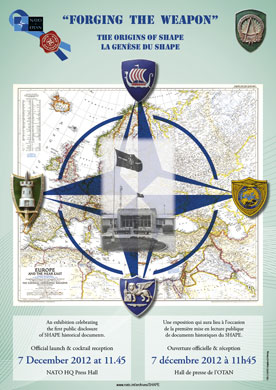NATO Archives exhibition 'Forging the Weapon: the Origins of SHAPE'
Over the past decade, the NATO Archives, the SHAPE Historical Office, SHAPE Registry and Records, and SHAPE Information and Knowledge Management have been working together to digitize large numbers of microfilm reels containing classified historical documents originating from SHAPE.

These documents provide an unparalleled look at the challenging process of establishing NATO’s command structure and the efforts made by the Supreme Allied Commander Europe (SACEUR), his staff, his subordinate commands and the NATO member nations to create an effective military force capable of defending the Alliance’s territory. Thanks to the support of the North Atlantic Council and the NATO Archives Committee, these historical documents have finally been declassified and disclosed to the public, marking the first time that researchers will have access to primary source information about the creation and activation of SHAPE.

On 7 December 2012, the NATO Archives celebrated this milestone with a public multimedia exhibition titled “Forging the Weapon’: The Origins of SHAPE’, which used the newly declassified SHAPE documents, along with rare photos and film footage, to present the formative years of NATO’s military structure. Assistant Secretary General for Executive Management Ambassador William Eaton opened the exhibition by welcoming a large crowd of invited guests that included the international members of the Archives Committee and special guest speakers Lt. General William Gaskin, the Deputy Chairman of the Military Committee, and Lt. General Phillippe Stoltz, the Vice Chief of Staff of SHAPE.
In his opening remarks, Lt. General Gaskin invoked Sir Winston Churchill to frame the importance of the archival work at NATO in offering valuable insight and perspective to historical events in relation to a modern security environment: ‘The farther backward you can look’, he quoted, ‘the farther forward you are likely to see.’ Gaskin praised the NATO Archives, the SHAPE Historical Office and SHAPE Registry and Records for their diligence and commitment in identifying, assembling and declassifying the thousands of pages of SHAPE documents. ‘Not only are you the keeper of NATO’s history’, he said, ‘you are the Alliance’s story-teller.’
In his following speech, Lt. General Stoltz recounted the story about how the original copies of SHAPE’s early historical records were destroyed after being microfilmed in order to save space. ‘While it may sound horrible to the archivists among you’, he reassured, ‘the reality is that because of this microfilming project a far greater percentage of key historical documentation has survived than would have been the case if the documents had been stored in hardcopy for so many decades.’ Lt. General Stoltz concluded by thanking the North Atlantic Council and the Archives Committee for their important support in preserving this key part of the Alliance’s history.
A selection of these publicly disclosed SHAPE documents were reprinted in the companion booklet for the exhibition, which also included a DVD containing the short NATO film ALLIANCE FOR PEACE (1953) and an edited newsreel of rare film clips featuring the first four SACEURs.
For online access to the SHAPE Histories and all of their related documents, please visit the NATO Archives website at: www.nato.int/archives/SHAPE. Additional SHAPE historical documents will be added periodically to the website in 2013 as they undergo the declassification and public disclosure process.
For complete access to the thousands of other declassified documents that have been publicly disclosed, researchers and others interested in the history of the Organization are welcome to visit the NATO Archives Reading Room at NATO HQ in Brussels.
All photos courtesy and copyright of Didier Kories.
